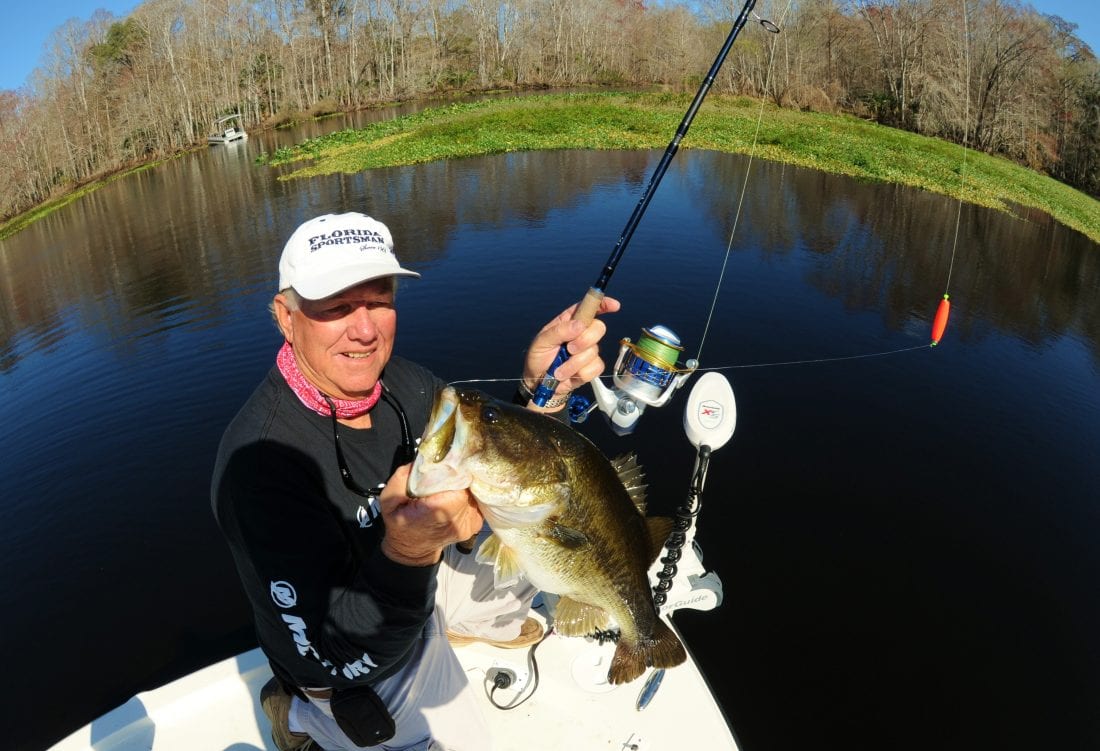NE Trophy Bass
Date: January 7, 2019
Title: NE Trophy Bass
Author: Terry D. Lacoss
Photo – A deadly trophy bass technique involves coaching large wild shiners to swim deep under a variety of aquatic vegetations. The month of February is considered one of Northeast Florida’s best month for targeting trophy largemouth bass weighing over the ten-pound mark.
There is a boat load of angling tactics when targeting Northeast Florida trophy largemouth bass, however the time of year is more important than how good a bass fisherman you are.
And oftentimes, where you chose to test your bass fishing skills has to be your priority.
Certainly, most freshwater fishermen only dream of catching a double-digit Florida largemouth bass, while a select group of seasoned bass fishermen accomplish this feat on a regular basis. This winter has produced super mild weather conditions, promising some of Florida’s very best trophy bass fishing of the year. Typically, the spawning season begins in late January and runs right through the month of May. However, a key time to target large female bass will come during the full moon of February, which occurs on February 19th.
Way back in time during the 1997 River City bass Tournament, Gary Pittman weighed in seven bass that tipped the tournament scales at 40.11-pounds. Gary caught his winning catch while working a plastic crawdad with a tantalizing slow retrieve in an area of the St. John’s River where bass were beginning to spawn. Pitman’s career largest bass weighed 14.12-pounds and was taken during the month of February while fishing Florida’s “Withlacoochee River.
“I look for some of the best late winter bass fishing to come during the afternoon hours when male bass have moved off from the beds and larger female bass move onto the beds to spawn,” Gary Pittman said. “Clear water is critical during the early spawning season as clean water typically warms up faster than stained water.”
One of Gary’s many successful trophy bass fishing techniques includes pitching to small open pockets of water in the grass. Some of his best trophy bass fishing comes from shallow sloughs off from the river and bass lake shorelines that harbor shallow sandy weed bottoms.
“Every trophy bass has its own personality,” Gary Pittman explains. “That’s why I carry a variety of bass tackle on board my fishing boat, including spinning and casting tackle. I prefer the fluorocarbon fishing lines testing from ten to twenty-pound test. I also bass fish with a variety of bass lures, however the plastic tube lure has to be my favorite in the shad, white, or purple color patterns. A second choice would be a plastic crawfish in the same color patterns. I rig the soft plastic lures with a 5/0 bass hook and depending on the bass cover, attach a 3/16 to 1-ounce bullet weight onto my bass line. Obviously the thicker the cover, the heavier the worm weight I will pitch with.”
Lots of skill is also needed when detecting strikes from trophy bass during the spawning season when bass will typically pick up a lure with their mouth and drop it off from their bed with little if any signs of a strike.
“I would have to say that I feel only one out of ten trophy bass strikes during the spawning season,” Gary Pittman said. “Most of my strikes are detected by actually watching large female bass mouth my bass lure. That is why it’s extremely important to fish for spawning bass in clear areas of the lake or rivers so that you can not only locate trophy bass, but also see giant female bass strike your bass lures.”
One of my favorite winter bass fishing patterns includes fishing small lakes located in Northeast Florida. Many of these lakes are located on private property which makes it even better if I can get permission to access the lake. I also prefer to fish from a small “Jon” boat that can access the shallow portion of the lake where bass are more than likely spawning.
During a past trophy bass fishing trip to a small Northeast Florida lake I was fishing solo from a 14-foot Jon boat when I noticed a huge female bass laying like a log in her sandy bed. I tried catching her with a variety of lures, without success. I then beached my boat and began flipping a small jig right in front of her face, this bass was megaton!
She finally snapped at the jig, which I quickly set the hook before she spit it out. Immediately the big bass swam out to deep water, turned and jumped. Her mouth was larger than a five-gallon bucket and I could clearly see the jig hook barely gripping her tremendous mouth. She tossed my jig and I have for years tried to figure how much she would have weighed. I’m guessing between 14-15 pounds.
Bass fishermen are encouraged to release their trophy bass and purchase a replica mount which will last for eternity. For current freshwater fishing regulation please visit www.myfwc.com.
“N.E. Trophy Bass”
By Terry D. Lacoss

